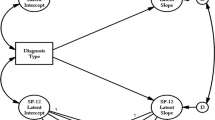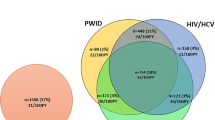Abstract
Improving outcomes for people with HIV and mental illness will be critical to meeting the goals of the US National HIV/AIDS Strategy. In a retrospective analysis of the 2008–2010 cycles of the locally representative Philadelphia Medical Monitoring Project, we compared the proportions of HIV-infected adults with and without mental illness: (1) retained in care (≥2 primary HIV visits separated by ≥90 days in a 12-month period); (2) prescribed antiretroviral therapy (ART) at any point in a 12-month period; and (3) virally suppressed (HIV-1 RNA ≤200 copies/mL at the last measure in the 12-month period). Multivariable regression assessed associations between mental illness and the outcomes, adjusting for age, gender, race/ethnicity, insurance, alcohol abuse, injection drug use, CD4 count, and calendar year. Of 730 HIV-infected persons, representative of 9409 persons in care for HIV in Philadelphia, 49.0 % had mental illness. In adjusted analyses, there were no significant differences in retention (91.3 vs. 90.3 %; AOR 1.30, 95 % CI 0.63–2.56) and prescription of ART (83.2 vs. 88.7 %; AOR 0.79, 95 % CI 0.49–1.25) between those with and without mental illness. However, mentally ill patients were less likely to achieve viral suppression than those without mental illness (65.9 vs. 74.4 %; AOR 0.64, 95 % CI 0.46–0.90). These findings argue for the need to optimize ART adherence in this population.
Similar content being viewed by others
References
Buckingham E, Schrage E, Cournos F. Why the treatment of mental disorders is an important component of HIV prevention among people who inject drugs. Adv Prev Med. 2013;2013:690386.
Angelino AF. Impact of psychiatric disorders on the HIV epidemic. Top HIV Med. 2008;16(2):99–103.
Carey MPWL, Carey KB. Prevalence of infection with HIV among the seriously mentally ill: review of research and implications for practice. Prof Psychol Rev. 1995;26:262–8.
McKinnon K, Cournos F. HIV infection linked to substance use among hospitalized patients with severe mental illness. Psychiatr Serv. 1998;49(10):1269.
Cournos F, McKinnon K. HIV seroprevalence among people with severe mental illness in the United States: a critical review. Clin Psychol Rev. 1997;17(3):259–69.
Walkup J, Blank MB, Gonzalez JS, et al. The impact of mental health and substance abuse factors on HIV prevention and treatment. J Acquir Immune Defic Syndr. 2008;47(Suppl 1):S15–9.
Yehia BR, Cui W, Thompson WW, et al. HIV testing among adults with mental illness in the United States. AIDS Patient Care STDs. 2014;28(12):628–34.
Bing EG, Burnam MA, Longshore D, et al. Psychiatric disorders and drug use among human immunodeficiency virus-infected adults in the United States. Arch Gen Psychiatry. 2001;58(8):721–8.
Ickovics JR, Hamburger ME, Vlahov D, et al. Mortality, CD4 cell count decline, and depressive symptoms among HIV-seropositive women: longitudinal analysis from the HIV Epidemiology Research Study. JAMA. 2001;285(11):1466–74.
Ickovics JR, Milan S, Boland R, et al. Psychological resources protect health: 5-year survival and immune function among HIV-infected women from four US cities. AIDS. 2006;20(14):1851–60.
Pence BW, Miller WC, Gaynes BN, Eron JJ Jr. Psychiatric illness and virologic response in patients initiating highly active antiretroviral therapy. J Acquir Immune Defic Syndr. 2007;44(2):159–66.
Blank MB, Eisenberg MM. Tailored treatment for HIV+ persons with mental illness: the intervention cascade. J Acquir Immune Defic Syndr. 2013;63(Suppl 1):S44–8.
Yehia B, Frank I. Battling AIDS in America: an evaluation of the National HIV/AIDS Strategy. Am J Public Health. 2011;101(9):e4–8.
Gardner EM, Young B. The HIV care cascade through time. Lancet Infec Dis. 2014;14(1):5–6.
Rodger AJ, Lodwick R, Schechter M, et al. Mortality in well controlled HIV in the continuous antiretroviral therapy arms of the SMART and ESPRIT trials compared with the general population. AIDS. 2013;27(6):973–9.
Arribas JR, Eron J. Advances in antiretroviral therapy. Curr Opin HIV AIDS. 2013;8(4):341–9.
Cohen CJ, Meyers JL, Davis KL. Association between daily antiretroviral pill burden and treatment adherence, hospitalisation risk, and other healthcare utilisation and costs in a US medicaid population with HIV. BMJ Open. 2013;3(8):e003028. doi:10.1136/bmjopen-2013-003028.
Berry SA, Fleishman JA, Moore RD, Gebo KA, Network HIVR. Trends in reasons for hospitalization in a multisite United States cohort of persons living with HIV, 2001-2008. J Acquir Immune Defic Syndr. 2012;59(4):368–75.
Bangsberg DR, Ragland K, Monk A, Deeks SG. A single tablet regimen is associated with higher adherence and viral suppression than multiple tablet regimens in HIV+ homeless and marginally housed people. AIDS. 2010;24(18):2835–40.
Yehia BR, Fleishman JA, Hicks PL, et al. Inpatient health services utilization among HIV-infected adult patients in care 2002-2007. J Acquir Immune Defic Syndr. 2010;53(3):397–404.
Blair JM, McNaghten AD, Frazier EL, Skarbinski J, Huang P, Heffelfinger JD. Clinical and behavioral characteristics of adults receiving medical care for HIV infection—Medical Monitoring Project, United States, 2007. MMWR Surveill Summ. 2011;60(11):1–20.
McNaghten AD, Wolfe MI, Onorato I, et al. Improving the representativeness of behavioral and clinical surveillance for persons with HIV in the United States: the rationale for developing a population-based approach. PLoS ONE. 2007;2(6):e550.
The White House Office of National AIDS Policy. The National HIV/AIDS Strategy of the United States. 2010. https://www.whitehouse.gov/sites/default/files/uploads/NHAS.pdf. Accessed 25 Feb 2015.
Blank MB, Himelhoch SSH, Balaji AB, Metzger DS, Dixon LB, Rose CE, Oraka E, Davis-Vogel A, Thompson WW, Heffelfinger JD. A multisite study of the prevalence of HIV using rapid testing in mental health settings. Am J Public Health. 2014;104(12):2377–84.
Department of Health and Human Services: Guidelines for the Use of Antiretroviral Agents in HIV-1-Infected Adults and Adolescents. http://www.aidsinfo.nih.gov/contentfiles/lvguidelines/adultandadolescentgl.pdf. Accessed 10 March 2015.
Mugavero MJ, Westfall AO, Zinski A, et al. Measuring retention in HIV care: the elusive gold standard. J Acquir Immune Defic Syndr. 2012;61(5):574–80.
Frankel MR, McNaghten A, Shapiro MF, et al. Suppl 1: a probability sample for monitoring the HIV-infected population in care in the US and in selected states. Open AIDS. 2012;6:67.
Centers for Disease Control and Prevention. Epidemiology of HIV/AIDS United States. MMWR Surveill Summ. 2006;55(21):589–92.
Ickovics JR, Hamburger ME, Vlahov D, et al. Mortality, CD4 cell count decline, and depressive symptoms among HIV-seropositive women: longitudinal analysis from the HIV Epidemiology Research Study. JAMA. 2001;285(11):1466–74.
Doshi RK, Milberg J, Isenberg D, et al. High rates of retention and viral suppression in United States HIV safety net system: HIV care continuum in the Ryan White HIV/AIDS Program, 2011. Clin Infect Dis. 2015;60(1):117–25.
Magnus M, Jones K, Phillips G, et al. Characteristics associated with retention among African American and Latino adolescent HIV-positive men: results from the outreach, care, and prevention to engage HIV-seropositive young MSM of color special project of national significance initiative. J Acquir Immune Defic Syndr. 2010;53(4):529–36.
Mocroft A, Madge S, Johnson AM, et al. A comparison of exposure groups in the EuroSIDA study: starting highly active antiretroviral therapy (HAART), response to HAART, and survival. J Acquir Immune Defic Syndr. 1999;22(4):369–78.
Fairfield KM, Libman H, Davis RB, Eisenberg DM, Phillips RS. Delays in protease inhibitor use in clinical practice. J Gen Intern Med. 1999;14(7):395–401.
Turner BJ, Fleishman JA, Wenger N, et al. Effects of drug abuse and mental disorders on use and type of antiretroviral therapy in hiv-infected persons. J Gen Intern Med. 2001;16(9):625–33.
Bogart LM, Kelly JA, Catz SL, Sosman JM. Impact of medical and nonmedical factors on physician decision making for HIV/AIDS antiretroviral treatment. J Acquir Immune Defic Syndr. 2000;23(5):396–404.
Althoff KN, Buchacz K, Hall HI, et al. U.S. trends in antiretroviral therapy use, HIV RNA plasma viral loads, and CD4 T-lymphocyte cell counts among HIV-infected persons, 2000 to 2008. Ann Intern Med. 2012;157(5):325–35.
Pouwer F, Nefs G, Nouwen A. Adverse effects of depression on glycemic control and health outcomes in people with diabetes: a review. Endocrinol Metab Clin North Am. 2013;42(3):529–44.
Barth J, Schumacher M, Herrmann-Lingen C. Depression as a risk factor for mortality in patients with coronary heart disease: a meta-analysis. Psychosom Med. 2004;66(6):802–13.
Springer SA, Dushaj A, Azar MM. The impact of DSM-IV mental disorders on adherence to combination antiretroviral therapy among adult persons living with HIV/AIDS: a systematic review. AIDS Behav. 2012;16(8):2119–43.
Wyatt GE, Longshore D, Chin D, et al. The efficacy of an integrated risk reduction intervention for HIV-positive women with child sexual abuse histories. AIDS Behav. 2004;8(4):453–62.
Weber R, Christen L, Christen S, et al. Effect of individual cognitive behaviour intervention on adherence to antiretroviral therapy: prospective randomized trial. Antivir Ther. 2004;9(1):85–96.
Yun LW, Maravi M, Kobayashi JS, Barton PL, Davidson AJ. Antidepressant treatment improves adherence to antiretroviral therapy among depressed HIV-infected patients. J Acquir Immune Defic Syndr. 2005;38(4):432–8.
SAMHSA: Primary and Behavioral Health Care Integration. http://www.samhsa.gov/grants/grant-announcements/sm-15-005. Accessed 25 Feb 2015.
SAMHSA-HRSA Center for Integreated Solutions: Behavioral health homes for people with mental health & substance use conditions. http://www.integration.samhsa.gov/clinical-practice/cihs_health_homes_core_clinical_features.pdf. Accessed 25 Feb 2015.
Palepu A, Tyndall M, Yip B, O’Shaughnessy MV, Hogg RS, Montaner JS. Impaired virologic response to highly active antiretroviral therapy associated with ongoing injection drug use. J Acquir Immune Defic Syndr. 2003;32(5):522–6.
Anastos K, Schneider MF, Gange SJ, et al. The association of race, sociodemographic, and behavioral characteristics with response to highly active antiretroviral therapy in women. J Acquir Immune Defic Syndr. 2005;39(5):537–44.
Acknowledgments
We would like to acknowledge the staff of the Philadelphia Department of Health AIDS Activities Coordinating Office including Jane Baker, Coleman Terrell and Mark Shpaner. This work was supported by the National Institutes of Health (K23-MH097647 to BRY), the Penn Mental Health AIDS Research Center (P30-MH097488), the Penn Center for AIDS Research (P30 AI 045008), and the Centers for Disease Control and Prevention (PS13-130202 #U62/003959 to KAB).
Author information
Authors and Affiliations
Corresponding author
Appendix
Appendix
See Appendix Table 5.
Rights and permissions
About this article
Cite this article
Yehia, B.R., Stephens-Shield, A.J., Momplaisir, F. et al. Health Outcomes of HIV-Infected People with Mental Illness. AIDS Behav 19, 1491–1500 (2015). https://doi.org/10.1007/s10461-015-1080-4
Published:
Issue Date:
DOI: https://doi.org/10.1007/s10461-015-1080-4




